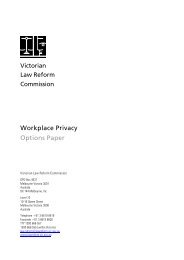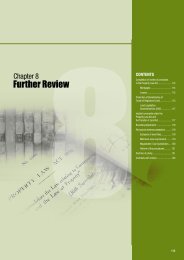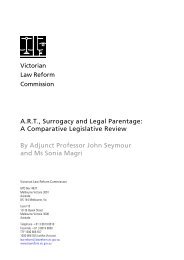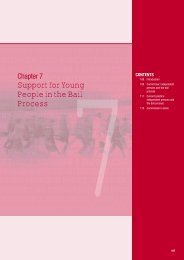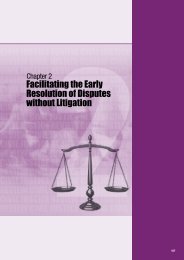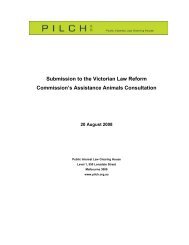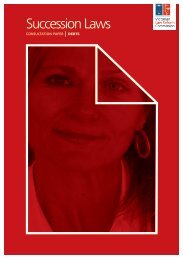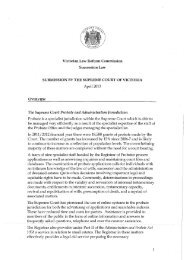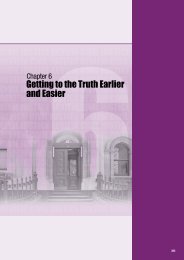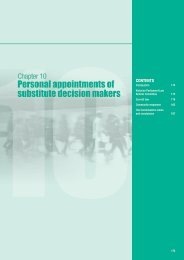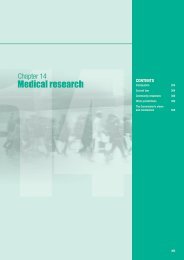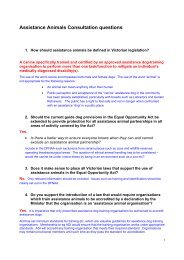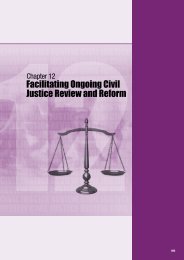Crimes Mental Impairment consultation paper.pdf - Victorian Law ...
Crimes Mental Impairment consultation paper.pdf - Victorian Law ...
Crimes Mental Impairment consultation paper.pdf - Victorian Law ...
Create successful ePaper yourself
Turn your PDF publications into a flip-book with our unique Google optimized e-Paper software.
2<br />
Protection of the community<br />
2.62 Connected to the principle of least restriction, but also a principle in its own right, is the<br />
principle of protecting the community from the danger that will be posed or may be likely<br />
due to a person’s mental condition. This has been described as the ‘social control’ policy. 64<br />
2.63 This principle is reflected throughout the CMIA by the notion of endangerment.<br />
Endangerment in this context is<br />
about the risk of harm. The gravity of the harm may be relevant to assessing the nature<br />
of the risk, but the probability of any risk, be it high or low, is the critical concept of<br />
endangerment … The ordinary meaning of endangerment entails the concept of chance<br />
or risk. 65<br />
2.64 The concept underpins the CMIA in two different ways:<br />
• Likely endangerment—the need to protect the community from the ‘likely danger’<br />
posed by a person.<br />
• Serious endangerment—the need to protect the community from their safety being<br />
‘seriously endangered’ by the person.<br />
2.65 The terms ‘likely endangerment’ and ‘serious endangerment’ have different meanings<br />
under the CMIA but there is some overlap in application. Assessing the risk of serious<br />
endangerment encompasses both the likelihood of the danger and the gravity of the<br />
possible harm if the danger eventuates. This can be contrasted with assessing the risk of<br />
likelihood of endangerment, which only encompasses how likely it is that any danger may<br />
eventuate, irrespective of the gravity of the possible harm. 66<br />
2.66 A person subject to a supervision order under the CMIA is included in the term<br />
‘community’ in terms of protection from danger, as well as any other specific people or<br />
members of the general community.<br />
2.67 Implicit in the balancing of the competing interests is the requirement that the court<br />
engage in future assessment. 67 The court must try to make an assessment of the current<br />
or future risk of dangerousness posed by a person who is unfit to stand trial or not<br />
guilty because of mental impairment. This task requires the court to embrace notions of<br />
uncertainty and to consider the ‘likelihood of such [future] risk becoming a reality’. 68 The<br />
Commission considers some of the potential issues regarding the approach taken to this<br />
difficult task in Chapter 9.<br />
Rights of victims and family members<br />
2.68 The impact of decisions on victims and the family and carers of the person with a mental<br />
condition is also a significant consideration in the CMIA. This is relevant to the court’s<br />
task of balancing the rights of the accused person with the protection and interests of the<br />
community and ensuring that the victims have an opportunity to exercise their rights to<br />
be heard and be informed in CMIA matters.<br />
64 <strong>Victorian</strong> Sentencing Committee, above n 8, 413.<br />
65 NOM v DPP & Ors [2012] VSCA 198 (24 August 2012) [58].<br />
66 Ibid [64].<br />
67 See Re LN [1999] VSC 144R (6 May 1999) [6] which describes the task of future assessment as ‘forensic clairvoyance’.<br />
68 Ibid.<br />
21



